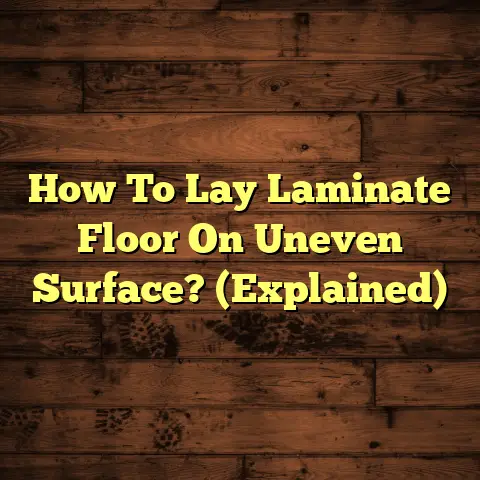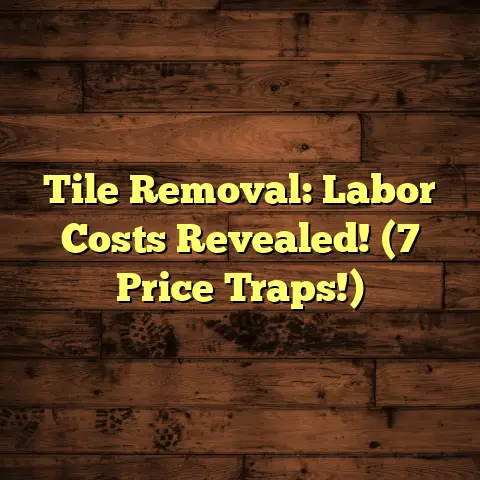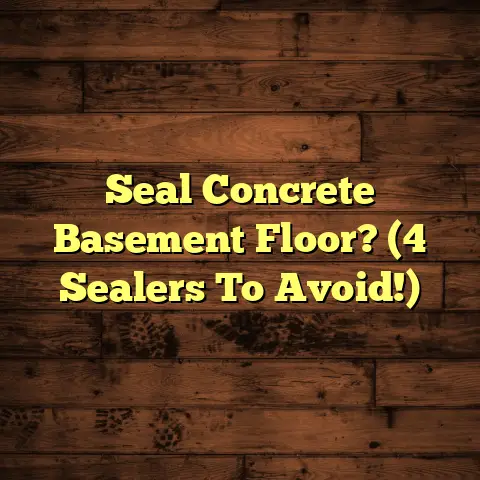Slippery Tiles: Fix NOW! (2 Fall-Proof Solutions!)
I’ve seen firsthand the nasty falls they can cause. As a flooring contractor for over 15 years, I’ve been called in after accidents more times than I’d like to admit.
Think about it: kids running around, elderly relatives visiting…one wrong step and BAM! A trip to the ER. And let’s be real, nobody wants that. Falls are the leading cause of injury and death from injury among older Americans.1
That’s why I’m fired up about helping you fix this problem right now. Forget those temporary fixes that barely work. I’m going to give you two rock-solid solutions that will make your tiles safe as houses.
This isn’t just about avoiding a fall. It’s about peace of mind. Knowing your family, your customers, or even you are safe walking on your floors? Priceless.
So, grab a coffee (carefully!), and let’s dive into making those slippery tiles a thing of the past. Ready to make your floors fall-proof? Let’s get to it!
Section 1: Understanding Why Tiles Become Slippery
Okay, so why are your tiles suddenly trying to betray you? It’s not just random bad luck. There’s actually some science behind it. Let’s break down the usual suspects.
Explore the Causes
Think of your tile floor as a tiny ecosystem. Lots of things can throw it out of balance and make it slippery. The biggest culprits? Moisture, the type of tile, the finish on the tile, and even what you’re using to clean.
Types of Tiles
Not all tiles are created equal. Some are naturally more slippery than others. Let’s look at some common types:
-
Ceramic: These are pretty common, and generally okay when dry. But add water? They can get slick. Think about that ceramic mug you almost dropped this morning!
-
Porcelain: These are denser than ceramic, which makes them more durable. However, that density can also mean they’re smoother and therefore, more slippery. Especially polished porcelain!
-
Marble: Oh, marble. So elegant, so… prone to slipperiness. Marble is naturally smooth, and when polished, it’s practically an ice rink. Plus, certain cleaning products can actually damage marble and make it even worse.
-
Quarry Tile: These are often used in commercial kitchens because they’re tough. They usually have a slightly textured surface, making them a better choice for slip resistance than some others.
The texture of the tile is key. A rougher surface gives your shoes something to grip. A smooth, polished surface? Not so much. The coefficient of friction (COF) is a measurement of how much resistance a surface offers to an object sliding across it. The higher the COF, the less slippery the surface. According to the American National Standards Institute (ANSI), a static COF of 0.50 or greater is considered safe for level surfaces.
Environmental Factors
Even the “least slippery” tile can become a hazard under the right conditions.
-
Moisture: Obvious, right? Water, spills, even humidity can turn your floor into a skating rink. Bathrooms and kitchens are prime danger zones.
-
Spills: Oil, grease, soap…anything that reduces friction can make things dicey.
-
Foot Traffic: Over time, foot traffic can actually polish some tiles, making them smoother and more slippery.
Importance of Addressing Slipperiness
Okay, so we know slippery tiles are bad. But let’s really drive home why you need to fix this.
-
Safety: This is the big one. Falls can lead to fractures, sprains, head injuries… the list goes on. Especially for young kids and older adults.
-
Liability: If someone falls on your property and gets hurt, you could be held liable. This is especially true in commercial settings. Think about it: a customer slips and breaks their wrist in your store? You’re potentially looking at a lawsuit.
-
Peace of Mind: Honestly, just knowing your floors are safe is a huge weight off your shoulders. You can relax and not constantly worry about someone taking a tumble.
Ignoring slippery tiles is like ignoring a leaky roof. It might seem like a small problem now, but it can lead to bigger, more expensive problems down the road. Trust me, I’ve seen it happen.
Section 2: Solution 1 – Anti-Slip Treatments
Alright, let’s get to the good stuff! You’ve got slippery tiles, now what? My first go-to solution is anti-slip treatments.
Overview of Anti-Slip Treatments
Think of anti-slip treatments as a “grip enhancer” for your tiles. They work by increasing the friction between your shoes and the floor, making it harder to slip.
These treatments come in a few different forms, but the basic idea is the same: make the surface less slippery.
Types of Treatments Available
Let’s break down the most common types of anti-slip treatments:
-
Chemical Treatments: These are coatings that react with the tile surface to create microscopic textures. They’re usually acid-based and can be very effective. But, they also require careful application. I’ve used treatments like SlipDoctors Stone Grip on commercial projects with great results. It etches the surface of the tile, creating an almost invisible texture that significantly increases grip.
-
Textured Coatings: These are thicker coatings that add a physical texture to the tile surface. Think of it like adding a thin layer of sandpaper. They’re generally more durable than chemical treatments, but they can also change the look of your tiles more noticeably. Epoxy coatings with added grit are a common example.
-
DIY vs. Professional Application: This is a big question. Can you apply these treatments yourself? Maybe. Chemical treatments can be tricky and require proper safety gear (gloves, eye protection, ventilation). Textured coatings are a bit more forgiving, but still require careful prep work and application to avoid bubbles or uneven coverage. I always recommend hiring a professional, especially for chemical treatments. The cost is usually worth it for the peace of mind and guaranteed results.
Step-by-Step Guide to Applying an Anti-Slip Treatment
Okay, let’s say you’re feeling brave and want to tackle this yourself. Here’s a general guide. Remember to always follow the manufacturer’s instructions for the specific product you’re using!
-
Materials Needed:
- Anti-slip treatment (chemical or textured)
- Cleaner (appropriate for your tile type)
- Scrub brush
- Rags or mop
- Buckets
- Gloves
- Eye protection
- Ventilation (open windows or use a fan)
- Painter’s tape (to protect adjacent surfaces)
- Applicator (roller, brush, or spray, depending on the product)
-
Preparation Steps:
- Clean the Tiles: This is crucial. The treatment won’t bond properly to a dirty surface. Use a good quality cleaner and scrub the tiles thoroughly. Rinse well and let them dry completely.
- Protect Adjacent Surfaces: Use painter’s tape to mask off baseboards, walls, or anything else you don’t want to get the treatment on.
- Ventilate the Area: Open windows and doors to provide plenty of fresh air. Some treatments have strong fumes.
-
Application Process:
- Mix the Treatment: If required, mix the treatment according to the manufacturer’s instructions.
- Apply the Treatment: Use the recommended applicator to apply a thin, even coat of the treatment to the tiles. Work in small sections to ensure even coverage.
- Follow the Instructions: Pay close attention to the manufacturer’s instructions regarding application technique and dwell time (how long the treatment needs to sit on the surface).
- Rinse (if required): Some chemical treatments require rinsing after a certain amount of time. Again, follow the manufacturer’s instructions.
-
Curing Time and Maintenance:
- Curing Time: This is the time it takes for the treatment to fully bond to the tile surface. It can range from a few hours to several days. Avoid walking on the treated surface during the curing time.
- Maintenance: Clean the treated tiles regularly with a mild cleaner. Avoid using abrasive cleaners or harsh chemicals, as these can damage the treatment. Reapply the treatment as needed, depending on wear and tear.
Case Studies/Examples
I once worked on a project for a local restaurant that had a serious problem with slippery kitchen tiles. They had already had several employee injuries due to falls. We used a chemical anti-slip treatment (SlipDoctors Stone Grip, specifically) and the difference was night and day. They haven’t had a single slip-related injury since.
I also helped a homeowner who had polished marble floors in their bathroom. It was beautiful, but incredibly dangerous. We applied a textured coating that gave the floor much-needed grip without completely ruining the look of the marble.
These are just a couple of examples, but I’ve seen anti-slip treatments work wonders in all sorts of situations.
Section 3: Solution 2 – Non-Slip Mats and Rugs
Okay, so anti-slip treatments are great, but they’re not always the easiest or most immediate solution. That’s where non-slip mats and rugs come in.
Introduction to Non-Slip Mats and Rugs
Think of non-slip mats and rugs as the “band-aid” solution for slippery tiles. They provide an instant layer of grip and safety where you need it most. Plus, they’re relatively inexpensive and easy to install.
Types of Mats and Rugs
Let’s explore the different types of non-slip mats and rugs available:
-
Material Choices:
- Rubber: Rubber mats are durable, water-resistant, and provide excellent grip. They’re a great choice for bathrooms, kitchens, and entryways. Look for mats with a textured surface for even better slip resistance.
- Vinyl: Vinyl mats are similar to rubber mats, but they’re often more affordable. They’re also easy to clean and come in a variety of colors and styles.
- Fabric: Fabric rugs with a non-slip backing can add warmth and style to a room while also providing slip resistance. Look for rugs with a rubber or latex backing to keep them in place.
-
Sizes and Designs:
- Size Matters: Choose mats and rugs that are appropriately sized for the area you want to cover. A small rug in a large entryway might not provide enough coverage, while an oversized mat in a small bathroom could be a tripping hazard.
- Design Considerations: Choose mats and rugs that complement your existing decor. There are tons of options available, from simple solid colors to intricate patterns.
Where to Use Non-Slip Mats
Here are some of the best places to use non-slip mats and rugs:
- Bathrooms: Bathrooms are notorious for slippery tiles. Place mats in front of the sink, shower, and toilet to provide extra grip.
- Kitchens: Kitchens are another high-risk area due to spills and moisture. Place mats in front of the sink, stove, and dishwasher.
- Entryways: Entryways can become slippery when wet or snowy. Place a mat inside the door to catch dirt and moisture and prevent slips.
- Stairways: Add non-slip treads to stairs for extra safety.
Step-by-Step Guide to Choosing and Placing Non-Slip Mats
Alright, let’s get practical. Here’s how to choose and place non-slip mats like a pro:
-
Selection Criteria:
- Assess Your Needs: Consider the size of the area you want to cover, the type of tile you have, and the level of slip resistance you need.
- Choose the Right Material: Select a material that is appropriate for the environment. Rubber and vinyl are good choices for wet areas, while fabric rugs are better suited for dry areas.
- Consider Style: Choose mats and rugs that complement your existing decor.
- Read Reviews: Check online reviews to see what other customers have to say about the mat or rug you’re considering.
-
Installation Process:
- Clean the Floor: Before placing the mat or rug, clean the floor thoroughly to remove any dirt or debris.
- Position the Mat: Place the mat or rug in the desired location.
- Secure the Mat (if necessary): Some mats and rugs have a non-slip backing that will keep them in place. If your mat or rug doesn’t have a non-slip backing, you can use rug tape or a non-slip pad to secure it to the floor.
-
Maintenance Tips:
- Clean Regularly: Clean your mats and rugs regularly to remove dirt and debris.
- Follow Manufacturer’s Instructions: Follow the manufacturer’s instructions for cleaning and care.
- Replace as Needed: Replace your mats and rugs when they become worn or damaged.
Real-Life Applications
I know a daycare center that uses non-slip rubber mats in all of their bathrooms and kitchens. They’ve significantly reduced the number of slip-and-fall accidents among the children.
I also have a friend who uses a non-slip rug in her entryway to protect her hardwood floors from water damage and prevent slips during the winter months.
These are just a couple of examples, but non-slip mats and rugs can be a lifesaver in a variety of situations.
Conclusion
So, there you have it! Two solid solutions for tackling slippery tiles. Whether you choose to go with anti-slip treatments or non-slip mats and rugs (or even both!), the important thing is to take action.
Don’t wait until someone gets hurt to address this problem. Take a few simple steps today to make your floors safer and more secure.
Remember, safety isn’t expensive, it’s priceless.
Now go forth and conquer those slippery tiles! You got this!
Footnotes
1: National Council on Aging, “Falls Prevention Facts,” https://www.ncoa.org/article/get-the-facts-on-falls-prevention





